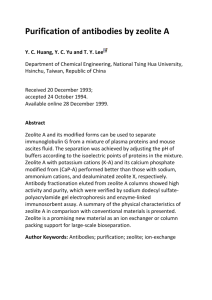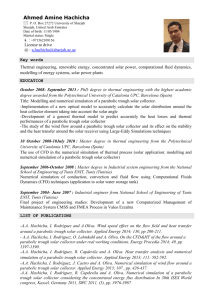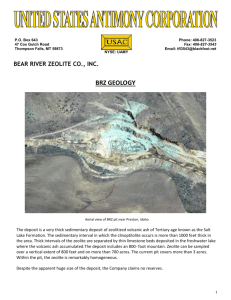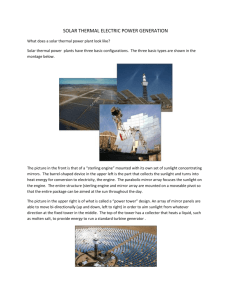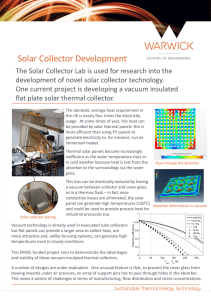Development and Performance Characteristics of a Low-Cost Parabolic Solar Collector
advertisement
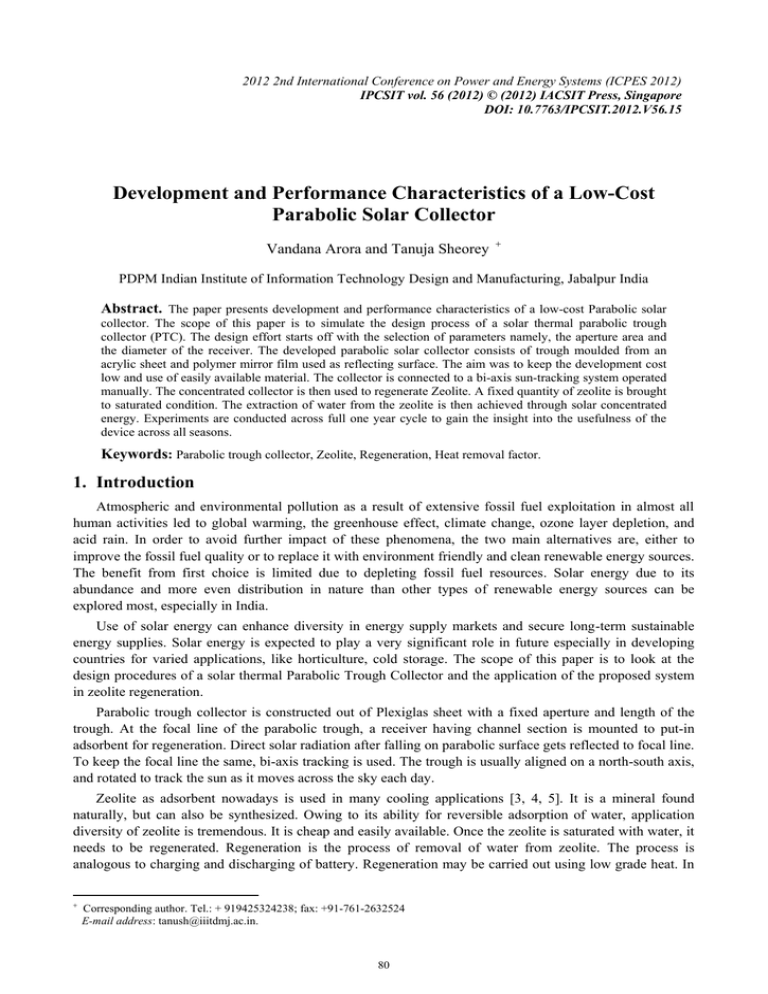
2012 2nd International Conference on Power and Energy Systems (ICPES 2012) IPCSIT vol. 56 (2012) © (2012) IACSIT Press, Singapore DOI: 10.7763/IPCSIT.2012.V56.15 Development and Performance Characteristics of a Low-Cost Parabolic Solar Collector Vandana Arora and Tanuja Sheorey PDPM Indian Institute of Information Technology Design and Manufacturing, Jabalpur India Abstract. The paper presents development and performance characteristics of a low-cost Parabolic solar collector. The scope of this paper is to simulate the design process of a solar thermal parabolic trough collector (PTC). The design effort starts off with the selection of parameters namely, the aperture area and the diameter of the receiver. The developed parabolic solar collector consists of trough moulded from an acrylic sheet and polymer mirror film used as reflecting surface. The aim was to keep the development cost low and use of easily available material. The collector is connected to a bi-axis sun-tracking system operated manually. The concentrated collector is then used to regenerate Zeolite. A fixed quantity of zeolite is brought to saturated condition. The extraction of water from the zeolite is then achieved through solar concentrated energy. Experiments are conducted across full one year cycle to gain the insight into the usefulness of the device across all seasons. Keywords: Parabolic trough collector, Zeolite, Regeneration, Heat removal factor. 1. Introduction Atmospheric and environmental pollution as a result of extensive fossil fuel exploitation in almost all human activities led to global warming, the greenhouse effect, climate change, ozone layer depletion, and acid rain. In order to avoid further impact of these phenomena, the two main alternatives are, either to improve the fossil fuel quality or to replace it with environment friendly and clean renewable energy sources. The benefit from first choice is limited due to depleting fossil fuel resources. Solar energy due to its abundance and more even distribution in nature than other types of renewable energy sources can be explored most, especially in India. Use of solar energy can enhance diversity in energy supply markets and secure long-term sustainable energy supplies. Solar energy is expected to play a very significant role in future especially in developing countries for varied applications, like horticulture, cold storage. The scope of this paper is to look at the design procedures of a solar thermal Parabolic Trough Collector and the application of the proposed system in zeolite regeneration. Parabolic trough collector is constructed out of Plexiglas sheet with a fixed aperture and length of the trough. At the focal line of the parabolic trough, a receiver having channel section is mounted to put-in adsorbent for regeneration. Direct solar radiation after falling on parabolic surface gets reflected to focal line. To keep the focal line the same, bi-axis tracking is used. The trough is usually aligned on a north-south axis, and rotated to track the sun as it moves across the sky each day. Zeolite as adsorbent nowadays is used in many cooling applications [3, 4, 5]. It is a mineral found naturally, but can also be synthesized. Owing to its ability for reversible adsorption of water, application diversity of zeolite is tremendous. It is cheap and easily available. Once the zeolite is saturated with water, it needs to be regenerated. Regeneration is the process of removal of water from zeolite. The process is analogous to charging and discharging of battery. Regeneration may be carried out using low grade heat. In Corresponding author. Tel.: + 919425324238; fax: +91-761-2632524 E-mail address: tanush@iiitdmj.ac.in. 80 the present study water is used as adsorbate and zeolite as adsorbent. Regeneration is carried out using solar direct heating by putting the saturated zeolite in the receiver. For practical feasibility study of the use of zeolite, the same sample of zeolite is reused over a period of 12 months to observe changes in adsorptive capacity. At ambient conditions, 1.25 kg of zeolite is saturated by 450 grams (450ml) of water. Adsorptive capacity was found to be the same across all weather conditions. The experimental results show that the sample quantity of zeolite is regenerated with maximum temperature attainable through PTC at about 60-65oC in all the weather conditions. However, the time of regeneration varies with weather condition which is about 2.5 hours in winter, 6 hours in rainy season and 1.5 hours in summer. The efficiency of the collector is obtained as a function of heat of evaporation of water and direct solar incidence. 2. Design of Parabolic Trough Parabolic trough is defined in terms of depth d, width w and focal length f. Schematic of parabolic trough is shown in Fig. 1(a). The incident radiations coming from Sun i.e. infinity are falling parallelly on the trough surface. The parabolic curve would focus all the rays to a focal point. A trough normally extends the shape in three dimensions to turn the focal point into a focal line. The receiver is placed concentrically along this focal line. (b) (a) Fig. 1: (a) Schematic of Parabolic Through. (b) Matlab plot showing variation in parabolic profile with rim angle for a fixed aperture of 1 meter. Equation 1 [1] is the equation of parabola plotted on x-y axes. To obtain focal length of parabolic curve for the given w and d, equation 2 has been used. 𝑑 (1) 𝑦= ∗ 𝑥2 2 (.5𝑤) (2) 𝑤2 𝑓= 16𝑑 The rim angle is the angle between direct incident radiation on the reflective surface and the line joining focal point and extreme point of the reflective surface at the aperture width. The Equation 3 is used to calculate the rim angle based on the focal length, width and depth; cos ∅𝑅 = 2𝑓 (0.5𝑤)2 81 − (𝑑 − 𝑓)2 −1 (3) Fig. 1(b) shows variation in parabolic profile with rim angle for a fixed aperture of 1 meter obtained from Matlab programming. As can be seen clearly, with the rim angle decreasing, the collector area increases. It will increase solar incidence but at the same time will increase heat losses due to convection and radiation. Therefore reducing the rim angle in the trough is not advantageous. In the present study, trough collector is designed with rim angle of 90o. It gives an optimum intercept factor as well as the depth equal to the focal length. 3. Fabrication of Collector 3.1 Parabolic Trough The proposed trough collector consists of low-cost Plexiglas sheet of 2.5mm thickness, which has undergone a careful deformation process that was necessary to bring it to parabolic shape as shown in Fig. 2(a). The material is easily available and can be given requisite shape. For the easy manoeuvrability of the collector system, the aperture width of the trough is taken 1m and its focal length is 0.25 m. The aperture area of the reflecting surface is 1.89 m2. To maintain the parabolic shape intact, cross-ribs made of cast iron are provided on the back surface. For reflective surface of the collector, locally available silverite polymer mirror film (150microns) was tested for reflectivity and used on the collector. The trough collector is then mounted on wheeled stand made of slotted iron. The specific mirror film is economic, light and has a high reflectivity coefficient of 0.80. The environmental stability of the reflective surface was monitored for 12 months. 3.2 Receiver The purpose of the designed parabolic trough collector was to regenerate zeolite at atmospheric pressure and temperature. Regeneration process was carried out in the receiver placed concentrically along the focal line of the collector. Out of many shapes thought of, from circular to square, rectangular section was finalized. The reason being larger spread area available for heat absorption from reflection. The section is opened from the top to give it the shape of channel section as shown in Fig. 2(b), which will serve for exit of evaporated water vapour. Channel section made of Aluminium is used for the purpose. Aluminium makes a good conductor of heat because of its free electrons that can quickly pass on the energy that is applied to it. (b) (a) Fig. 2: Photograph of Developed Parabolic trough collector; (b): Channel shaped Receiver. The size of the channel was decided based on two factors, 1. local availability of channel section and 2. Concentration ratio desirable. The opening of the channel section was carefully designed taking into consideration the maximum tilt of the collector while tracking the sun during the day and to avoid spilling of the zeolite. The final channel dimensions used for the present study are 1.91 m * 6.5 cm * 3.8 cm with the opening of 3.9 cm at the top. Three gates are provided on one side of the channel for easy removal of the regenerated zeolite. 82 3.3 Sun-Tracking Mechanism Manually operated bi-axis sun-tracking system was designed and manufactured in the Institute laboratory on abrasive water jet machine. The tracking mechanism was developed to rotate the collector about north-south axes. It consisted of semi-circular toothed gear with 18 teeth, each providing step rotation of 10 degrees. Two such toothed gears were mounted on either side of the shaft that in turn is mounted on the bearings and carrying receiver section. The second axis i.e. vertical axis tracking is simply obtained through wheeled stand and based on manual observation of reflection of the sun on the reflective surface. 4. CALCULATION If (I) is the intensity of solar radiation, in W/m2 incident on the aperture plane of solar collector with the surface area of Ac, m2, then the amount of solar radiation received by the collector, (QI) is: 𝑄𝐼 = 𝐼 ∗ 𝐴𝐶 I = 197 W/m2 [6] Ac = 1.89 m2 ; (4) ; QI = 372.33 W A part of this radiation is reflected back and eventually absorbed by the receiver placed along the focal line as short wave radiation. The same heat then is conducted to zeolite. Thus, out of total solar energy received, (QIR ) is reflected and the same is received by the receiver surfaces. 𝑄𝐼𝑅 = 𝜌 ∗ 𝐼 ∗ 𝐴𝐶 ρ = 0.8 [3] (5) QIR = 297.864 W ; Again, a part of energy received by the receiver is lost to the surroundings by radiation and convection. The rate of heat loss (QO) depends on the overall heat transfer coefficient (UL) and the receiver surface temperature. 𝑄𝑂 = 𝑈𝐿 ∗ 𝐴𝐿 ∗ (𝑇𝐴𝐿 − 𝑇𝐴 ) UL =10W/ m2 ; AL= 0.31897 m2 ; TA = 21oC Mean Temperature of the day (6) ; QO= 140.346 W where, TAL = Average Surface temperature of the receiver; TA=Mean temperature during the day; AL= Area of the Receiver Thus the rate of useful energy extracted by the receiver (QU), expressed as a rate of extraction under steady state conditions, is proportional to the rate of useful energy absorbed by the receiver, less the amount lost by the receiver to its surroundings. This is expressed as: 𝑄𝑈 = 𝑄𝐼𝑅 − 𝑄𝑂 = 𝜌 ∗ 𝐼 ∗ 𝐴𝐶 − 𝑈𝐿 ∗ 𝐴𝐿 (𝑇𝐴𝐿 − 𝑇𝐴 ) (7) QU = 297.864 - 140.346 = 157.5172W Heat of evaporation of water from Zeolite, (QEV), can be evaluated from the steam table at the mean temperature obtained during the experiment. Heat removal factor (FR) relates the actual useful energy gain of a receiver in terms of heat of evaporation (QEV) to the useful gain of the receiver.The collector heat removal factor (FR) can be expressed as: 𝐹𝑅 = 𝑄𝐸𝑉 (8) 𝑄𝑈 If average temperature of the zeolite of a day is 45oC, then QEV = 124.375W (Enthalpy of saturated steam – enthalpy of water at 45oC). 83 𝑓𝑅 = 124.375 = 0.79 157.5172 A measure of a parabolic trough collector performance is the collector efficiency (η) defined as 𝜂= 𝑄𝐸𝑉 = 42% 𝑄𝐼𝑅 5. Results Tests were conducted across 12 months span covering all the major seasonal changes. All the tests were carried out on the same sample of 1.25 kg of zeolite across the year. Zeolite sample is saturated with 450 ml of water in atmospheric conditions with soaking time of 10 minutes. The sample is then put into receiver section for regeneration. Temperature of the zeolite and the receiver surface were taken after every ½ hour. In all the tests to avoid over drying, the regeneration process is continued till zeolite temperature becomes constant between two consecutive observations. To validate the same, zeolite has been removed when temperature reaches to 50oC. The sample weight was taken which came out more than the dry weight of the zeolite. Based on the test conducted across one year span, the changes in heat removal factor and collector efficiency were obtained and listed in Table 1. Owing to dry winter condition in November 2011, collector efficiency was seen to be approximately approaching summer conditions of 2012. Efficiency obtained in monsoon conditions was very low due to presence of post-rains high humidity. Table 1.: Heat removal factor and collector efficiency in extreme seasons. Season Intensity of solar radiation (I), W/m2 Solar Energy Received by the Trough (QI), W Winter Summer Monsoon 197 231.5 230.55 372.33 437.5 436 Reflected Solar Energy received by the Receiver (QIR), W 297.864 350 349 Rate of heat loss (QO), W 140.346 105.260 105.26 Useful Energy Extracted by the Receiver (QU), W 157.5172 245 244 Heat of Evapora tion of water from the Zeolite (QEV), kJ 124.375 155 77.375 Collector Heat Removal Factor (FR) 0.79 0.63 0.317 Collector Efficiency (η), % 42 44 22 6. References [1] Balbir Singh, Mahinder Singh, and Fauziah Sulaiman. Designing a solar thermal cylindrical parabolic Trough concentrator by simulation. International Rio3 Congress. Rio de Janeiro: World Climate and Energy Event. 2003 [2] Fabio Struckmann. Analysis of a flat plate Collector. Project Report 2008 MVK160. Lund, Sweden .Heat and Mass Transport. 2008. [3] I. Palavras and G.C. Bakos. Development of a low-cost dish solar concentrator and its application in zeolite desorption, Renewable Energy 31 : 2006, 2422–2431 [4] Miguel Ramos, Rafael L. Espinoza, Manfred J. Horn. Evaluation of a zeolite-water solar adsorption Refrigerator. ISES Solar World Congress . Göteborg , Sweden. 2003. [5] Siegfried Kreussler And DetlefBolz. Experiments on Solar Adsorption Refrigeration Using Zeolite And Water, available at: http://ptp.irb.hr/upload/mape/kuca/26_Siegfried_Kreussler_EXPERIMENTS_ON_SOLAR_ADSORPTION_REF RIG.pdf [6] Solar Radiation Hand Book 2008. A joint Project of Solar Energy Centre, MNRE Indian Metrological Department. 84

